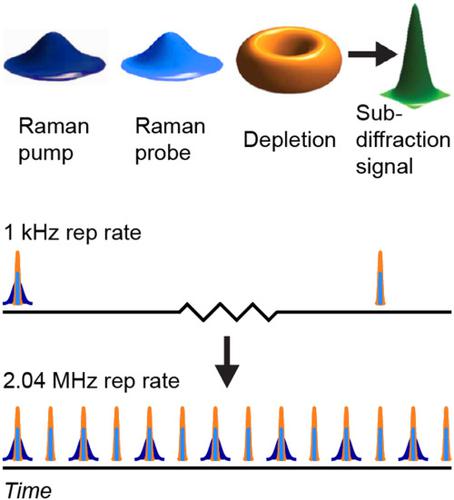当前位置:
X-MOL 学术
›
J. Raman Spectrosc.
›
论文详情
Our official English website, www.x-mol.net, welcomes your
feedback! (Note: you will need to create a separate account there.)
Stimulated Raman imaging below the diffraction limit with a MHz laser
Journal of Raman Spectroscopy ( IF 2.4 ) Pub Date : 2020-08-16 , DOI: 10.1002/jrs.5970 Christian T. Graefe 1 , David Punihaole 1 , Michael J. Lynch 1 , W. Ruchira Silva 1 , Renee R. Frontiera 1
Journal of Raman Spectroscopy ( IF 2.4 ) Pub Date : 2020-08-16 , DOI: 10.1002/jrs.5970 Christian T. Graefe 1 , David Punihaole 1 , Michael J. Lynch 1 , W. Ruchira Silva 1 , Renee R. Frontiera 1
Affiliation

|
Super‐resolution techniques based on Raman spectroscopy could be implemented as label‐free alternatives to fluorescence‐based techniques due to their chemically specific signal and multiplexing potential. In previous work, we developed a stimulated Raman‐based imaging technique that surpassed the diffraction limit using a toroidally shaped pulse to deplete the signal in a spatially defined area. The photophysical principles of depletion and improved spatial resolution were demonstrated using a 1‐kHz laser with high peak power that were able to efficiently drive depletion. However, this laser was not well suited for soft matter samples, which degraded under the intense beams. To improve the biological capabilities of our setup, we have adapted our technique for a 2.04‐MHz laser system. The increased repetition rate produces far more spectra per second, allowing us to decrease the pulse powers while maintaining reasonable acquisition times. Using the 2.04‐MHz laser, we are able to demonstrate strong signal depletion of 62% and resolution enhancements of 52%, which is comparable with the metrics obtained with the 1‐kHz laser. However, further improvements in resolution were not achieved despite increases in the depletion beam energy relative to the other beams. Frequency‐resolved optical gating analysis of the fundamental output of the 2.04 MHz laser indicated an inconsistent pulse phase and duration. We expect that the inconsistent depletion was a result of this pulse profile and conclude that efficient depletion depends on highly reproducible and stable laser pulses.
中文翻译:

用MHz激光激发的拉曼成像低于衍射极限
基于拉曼光谱的超分辨率技术由于其化学特异性信号和多路复用潜力,可以作为基于荧光的技术的无标签替代品。在先前的工作中,我们开发了一种基于拉曼光谱的受激成像技术,该技术使用环形脉冲在空间定义区域内耗尽信号,从而超过了衍射极限。使用具有高峰值功率的1 kHz激光器演示了耗尽的光物理原理和改进的空间分辨率,该激光器能够有效地驱动耗尽。但是,这种激光不适用于软物质样品,该软物质样品在强光束作用下会降解。为了提高设置的生物功能,我们将技术应用于2.04 MHz的激光系统。增加的重复频率每秒会产生更多的光谱,从而使我们能够在保持合理的采集时间的同时降低脉冲功率。使用2.04 MHz激光器,我们能够证明62%的强信号损耗和52%的分辨率增强,这与1 kHz激光器获得的指标相当。但是,尽管耗尽束能量相对于其他束增加,但分辨率仍无法进一步提高。对2.04 MHz激光器基本输出的频率分辨光学选通分析表明,脉冲相位和持续时间不一致。我们期望不一致的耗尽是该脉冲轮廓的结果,并得出结论,有效的耗尽取决于高度可再现且稳定的激光脉冲。使我们能够在保持合理的采集时间的同时降低脉冲功率。使用2.04 MHz激光器,我们能够证明62%的强信号损耗和52%的分辨率增强,这与1 kHz激光器获得的指标相当。但是,尽管耗尽束能量相对于其他束增加,但是分辨率仍未得到进一步的改善。对2.04 MHz激光器基本输出的频率分辨光学选通分析表明,脉冲相位和持续时间不一致。我们期望不一致的耗尽是该脉冲轮廓的结果,并得出结论,有效的耗尽取决于高度可再现且稳定的激光脉冲。使我们能够在保持合理的采集时间的同时降低脉冲功率。使用2.04 MHz激光器,我们能够证明62%的强信号损耗和52%的分辨率增强,这与1 kHz激光器获得的指标相当。但是,尽管耗尽束能量相对于其他束增加,但是分辨率仍未得到进一步的改善。对2.04 MHz激光器基本输出的频率分辨光学选通分析表明,脉冲相位和持续时间不一致。我们期望不一致的耗尽是该脉冲轮廓的结果,并得出结论,有效的耗尽取决于高度可再现且稳定的激光脉冲。我们能够展示出62%的强信号损耗和52%的分辨率增强,这与1 kHz激光器获得的指标相当。但是,尽管耗尽束能量相对于其他束增加,但是分辨率仍未得到进一步的改善。对2.04 MHz激光器基本输出的频率分辨光学选通分析表明,脉冲相位和持续时间不一致。我们期望不一致的耗尽是该脉冲轮廓的结果,并得出结论,有效的耗尽取决于高度可再现且稳定的激光脉冲。我们能够展示出62%的强信号损耗和52%的分辨率增强,这与1 kHz激光器获得的指标相当。但是,尽管耗尽束能量相对于其他束增加,但是分辨率仍未得到进一步的改善。对2.04 MHz激光器基本输出的频率分辨光学选通分析表明,脉冲相位和持续时间不一致。我们期望不一致的耗尽是该脉冲轮廓的结果,并得出结论,有效的耗尽取决于高度可再现且稳定的激光脉冲。对2.04 MHz激光器基本输出的频率分辨光学选通分析表明,脉冲相位和持续时间不一致。我们期望不一致的耗尽是该脉冲轮廓的结果,并得出结论,有效的耗尽取决于高度可再现且稳定的激光脉冲。对2.04 MHz激光器基本输出的频率分辨光学选通分析表明,脉冲相位和持续时间不一致。我们期望不一致的耗尽是该脉冲轮廓的结果,并得出结论,有效的耗尽取决于高度可再现且稳定的激光脉冲。
更新日期:2020-08-16
中文翻译:

用MHz激光激发的拉曼成像低于衍射极限
基于拉曼光谱的超分辨率技术由于其化学特异性信号和多路复用潜力,可以作为基于荧光的技术的无标签替代品。在先前的工作中,我们开发了一种基于拉曼光谱的受激成像技术,该技术使用环形脉冲在空间定义区域内耗尽信号,从而超过了衍射极限。使用具有高峰值功率的1 kHz激光器演示了耗尽的光物理原理和改进的空间分辨率,该激光器能够有效地驱动耗尽。但是,这种激光不适用于软物质样品,该软物质样品在强光束作用下会降解。为了提高设置的生物功能,我们将技术应用于2.04 MHz的激光系统。增加的重复频率每秒会产生更多的光谱,从而使我们能够在保持合理的采集时间的同时降低脉冲功率。使用2.04 MHz激光器,我们能够证明62%的强信号损耗和52%的分辨率增强,这与1 kHz激光器获得的指标相当。但是,尽管耗尽束能量相对于其他束增加,但分辨率仍无法进一步提高。对2.04 MHz激光器基本输出的频率分辨光学选通分析表明,脉冲相位和持续时间不一致。我们期望不一致的耗尽是该脉冲轮廓的结果,并得出结论,有效的耗尽取决于高度可再现且稳定的激光脉冲。使我们能够在保持合理的采集时间的同时降低脉冲功率。使用2.04 MHz激光器,我们能够证明62%的强信号损耗和52%的分辨率增强,这与1 kHz激光器获得的指标相当。但是,尽管耗尽束能量相对于其他束增加,但是分辨率仍未得到进一步的改善。对2.04 MHz激光器基本输出的频率分辨光学选通分析表明,脉冲相位和持续时间不一致。我们期望不一致的耗尽是该脉冲轮廓的结果,并得出结论,有效的耗尽取决于高度可再现且稳定的激光脉冲。使我们能够在保持合理的采集时间的同时降低脉冲功率。使用2.04 MHz激光器,我们能够证明62%的强信号损耗和52%的分辨率增强,这与1 kHz激光器获得的指标相当。但是,尽管耗尽束能量相对于其他束增加,但是分辨率仍未得到进一步的改善。对2.04 MHz激光器基本输出的频率分辨光学选通分析表明,脉冲相位和持续时间不一致。我们期望不一致的耗尽是该脉冲轮廓的结果,并得出结论,有效的耗尽取决于高度可再现且稳定的激光脉冲。我们能够展示出62%的强信号损耗和52%的分辨率增强,这与1 kHz激光器获得的指标相当。但是,尽管耗尽束能量相对于其他束增加,但是分辨率仍未得到进一步的改善。对2.04 MHz激光器基本输出的频率分辨光学选通分析表明,脉冲相位和持续时间不一致。我们期望不一致的耗尽是该脉冲轮廓的结果,并得出结论,有效的耗尽取决于高度可再现且稳定的激光脉冲。我们能够展示出62%的强信号损耗和52%的分辨率增强,这与1 kHz激光器获得的指标相当。但是,尽管耗尽束能量相对于其他束增加,但是分辨率仍未得到进一步的改善。对2.04 MHz激光器基本输出的频率分辨光学选通分析表明,脉冲相位和持续时间不一致。我们期望不一致的耗尽是该脉冲轮廓的结果,并得出结论,有效的耗尽取决于高度可再现且稳定的激光脉冲。对2.04 MHz激光器基本输出的频率分辨光学选通分析表明,脉冲相位和持续时间不一致。我们期望不一致的耗尽是该脉冲轮廓的结果,并得出结论,有效的耗尽取决于高度可再现且稳定的激光脉冲。对2.04 MHz激光器基本输出的频率分辨光学选通分析表明,脉冲相位和持续时间不一致。我们期望不一致的耗尽是该脉冲轮廓的结果,并得出结论,有效的耗尽取决于高度可再现且稳定的激光脉冲。










































 京公网安备 11010802027423号
京公网安备 11010802027423号